Abstract
An experiment was conducted to determine the possibility of using various levels of crude protein (CP) by providing laying hens with constant levels of digestible sulfur amino acid, threonine and lysine to improve performance and egg quality. The experiment was conducted as a completely randomized block design in a factorial arrangement (4×2) with 8 replicates of 10 hens in each. Factors included 4 levels of CP (18.5%, 17.5%, 16.5% and 15.5%) and 2 strains (LSL and Hy-Line W-36) of laying hens. Hens were fed experimental diets from 25 to 33 weeks of age. Production performance was measured for eight weeks and egg quality characteristics were determined at 29 and 33 weeks of age. Protein reduction decreased egg weight, egg mass and hen body weight linearly (P≤0.01). Egg production was not affected by protein reduction but feed efficiency, and average daily feed intake increased significantly (P≤0.01). Lohmann Selected Leghorn laying hens showed significantly higher egg production, egg weight, egg mass, weight gain, feed efficiency and feed intake compared to the W-36 laying hens (P≤0.01). Shell thickness increased linearly as protein levels decreased (P≤0.05). There were significant differences between two strains on the egg quality characteristics (P≤0.01). Significant (P≤0.05) CP × strain interactions were observed for hen weight, albumen height, Haugh units, yolk and shell percentage. Based on the results of this experiment, a reduction in dietary protein level (from 18.5% to 15.5%), without any alteration in digestible TSAA and Thr: Lys ratio, led to inferior egg mass and feed conversion ratio during the peak production period.
Introduction
Today, using synthetic amino acids such, as threonine, accompanied by lysine and methionine in the diet of laying hens is very common. The use of these amino acids makes the formulation of diets with minimum levels of crude protein feasible. Increased concern over the impact of modern poultry production systems on the environment (N pollution) has led to manipulation of our current diet formulations to decrease the level of N in the excreta. Because chickens can only utilize approximately 40% of the dietary protein, it seems logical to decrease the level of protein in the diet (Lopez and Leeson, Citation1995). To do so, synthetic amino acids must be used to meet the requirements of limiting amino acids due to the dilution of amino acids as the dietary protein is reduced. Due to the direct relationship between dietary protein level and N excretion (Lopez and Leeson, Citation1995), the logical solution to excessive excreta N is to reduce protein content in the diet. Many researchers have been successful in reducing N excretion by reducing the crude protein (CP) content in the diet with and without supplemental amino acids (Schutte et al., Citation1992; Summers, Citation1993; Jamroz et al., Citation1996; Blair et al., Citation1999) but with mixed effects on production variables. Penz and Jensen (Citation1991) reported decreased egg weight, body weight (BW), albumen, and yolk percentage, and poorer feed conversion in Dekalb XL hens from 28 to 34 weeks of age when fed lowprotein diets (13% protein) supplemented with Lys, Met, or Trp individually or in combination at a level of 20% above the NRC recommendations (NCR, Citation1984) and a low-protein diet supplemented with amino N supplying amino acids (Gly and Glu) to equal the 16% protein diet in total N.
Keshavarz and Jackson (Citation1992) fed a lowprotein diet supplemented with amino acids. Performance was equivalent to a positive control in some, but not all, performance traits. During the trial, all production parameters were increased by supplementing the low protein diets. The digestibility and bioavailability of amino acids in feed ingredients, and the improper ratio between essential amino acids in low protein diets may have been the reason for the inferior performance of hens fed a low protein, amino acid-supplemented diet (Keshavarz and Austic, Citation2004). For example, when decreasing protein from 19.0% to 14.2% in a corn-soy bean diet, the methionine content decreases from 0.28% to 0.24%. However, the lysine content decreases from 0.92% to 0.69%. Novak et al. (Citation2006) reported that reducing protein intake from 18.9 to 17.0 g/hen per day (20 to 43 weeks of age) and from 16.3 to 14.6 g/hen per day (43 to 63 weeks of age) decreased N excretion without resulting in any changes in egg production. Also, they reported that hens consuming diets containing 0.97 and 0.92 total sulfur amino acids to lysine produce eggs with improved shell quality as compared with other ratios during the experimental period. Novak et al. (Citation2006) suggested that further development of an ideal amino acid pattern would be needed to reduce the protein intake further, and the implementation of such a diet would require a cost reduction of currently available synthetic amino acids and changes in formulation of the diets to make such an approach economically feasible.
Egg quality has a genetic basis and the parameters of egg quality vary between strains of hens (Pandey et al., Citation1986; Silversides et al., Citation2006). Curtis et al. (Citation1985) found that different strains of laying hens vary significantly in eggshell quality. Luiting (Citation1990) reported that different strains of laying hens showed significant differences in feed efficiency because of genetic differences in physical activity, physical condition, basal metabolic rate, body temperature, and body composition.
There are only a few papers in the literature dealing with the application of various protein levels with a constant ratio of digestible sulfur amino acids and threonine to lysine on performance and egg quality of laying hens. The interaction between different protein levels in feed and different genetic profiles of laying hens has not been evaluated. In order to improve management practices to reduce protein content, the potential for differences due to strain must be evaluated. Therefore, this experiment was designed in order to improve management of protein levels in formulating the layer hens’ diet to reduce N excretion in the environment. The study used synthetic amino acid including threonine with no change in the three first limiting amino acids’ ratios. Consideration was also given to the effects of genetic differences.
Materials and methods
A total of 50,000 Selected Leghorn Lohmann (LSL) and 50,000 Hy-Line W-36 chicks (1-day old) were obtained from a local hatchery and raised from one to 16 weeks of age. Pullets of the two strains were raised separately in cages in two windowless, mechanically ventilated, light-proof growing houses. The pullets were fed corn and soybean meal formulated diets to meet nutrient requirement recommendations listed in the W-36 (Hy-Line International, Citation2008) and LSL (Lohmann LSL, 2007) Commercial Pullets Management Guides from 1-day old up to 16 weeks of age. The pullets in each room were exposed to the step-down light regimen. At 16 weeks of age, pullets were transferred to windowless laying houses. Hours of light were increased gradually until the total photoperiod reached 16 h/day and was kept constant to the end of the experiment (33 weeks of age). At 20 weeks of age, 360 pullets from each strain weighing close to management guideline recommendations were selected. Selected birds received commercial layer diets as per management guide recommendations up to 23 weeks of age. At 23 weeks of age, 40 over or under average weight birds from each strain were discarded leaving 320 laying hens from each strain. These were given a 2-week adaptation period. Egg production was recorded daily for each experimental unit throughout the adaptation period and average egg production rate (henday percent) was calculated. Hens were weighed at 25 weeks of age and experimental diets () were given to units. All hens had free access to feed and water throughout the experiment. The experiment consisted of a 4×2 factorial arrangement of the treatments with four dietary protein levels (18.5, 17.5, 16.5 and 15.5) and two white strains of laying hens (Hyline and LSL). There were 8 treatments with 8 replicates. Each replicate consisted of 10 hens that were housed in groups of 5 in 2 adjacent cages (45×50 cm). Digestible amino acid content of feed ingredient and experimental diets were recalculated using AminoDat software version 3.0 (Degussa AG Feed Additives, Evonik-Degussa GmbH, Hanau-Wolfgang, Germany).
The experiment consisted of a 2×4 factorial arrangement of the treatments with two white strains of laying hens (Hy-line and LSL) and four dietary protein levels (18.5, 17.5, 16.5 and 15.5). The groups of 5 birds per cage (45×50 cm) in two adjacent cages were considered an experimental replicate, and each dietary treatment was fed to 8 replicates (80 hens per treatment). Digestible amino acid content of feed ingredients and experimental diets was recalculated using AminoDat software version 3.0 (Degussa AG Feed Additives).
Feed consumption and egg production were recorded daily for each cage, whereas BW was obtained at the end of 25, 28, 31 and 33 weeks of age. Weekly, 1-day egg production was used for measuring egg weight. Egg mass was then calculated (egg weight × egg production). Every two weeks specific gravities were determined using 1-day egg production from a cage. Egg component, Haugh units, shell quality test and shell breaking strength were measured at the end of 29 and 33 weeks of age. Shell breaking strength and shell thickness were measured using an eggshell force gauge (model no. 55R1123, Instron Corp., Canton, MA, USA) and Karl Deutsch D-56 (Wuppertal Echometer 1061), respectively.
At the end of 29 weeks of age, a retention trial was conducted to determine percentage of protein retention. The amount of 2-day total feed intake of hens within the cage was measured and manure production was collected in aluminum pans and oven dried (80°C). Feed samples and dried excreta were ground with a laboratory hammer mill (1-mm screen, model Z-I Riechst, Stuttgart, Germany). Ground excreta were sifted (1-mm screen) to remove feathers before analysis. Protein analysis was conducted by Kjeldahl methodology (method 954.01; AOAC, Citation2000).
Experimental design for the aforementioned experiment was a randomized complete block design. Blocking was implemented to reduce the effect of lighting and temperature differences between rows. Data were analyzed by one-way ANOVA using the GLM procedure of SAS (SAS Institute, Citation2003) for traits that were not measured repeatedly throughout the experimental period. Egg production, egg weight, body weight, egg component, average daily feed intake, specific gravities and Haugh units were analyzed using MIXED SAS software (SAS Institute, Citation2003). Initial weight of hens, initial egg production and egg weight were considered as a random effect for body weight, egg production and egg weight, respectively. The following model was used to determine differences between treatment groups:
where Yijkl is the variable measured; μ is overall mean; Ri is effect as a result of the ith block; aj is effect of the jth level of A (CP levels); bk is effect of the kth level of B (strain); tl is effect of lth level of t (time of measurement); (ab)jk is interaction effect of the jth level of A and the kth level of B (CP levels × strain interaction); (a×t)ikl is interaction effect of jth level of A and lth level of t (CP levels × time interaction); and eijkl is error component. Means were compared by Tukey’s standardized multiple comparison tests. P≤0.05 was statistically significant.
Results
During the experiment, egg production was not affected by dietary CP level but a significant difference was seen on the egg production between the strains (P≤0.01) (). During the experimental period, Lohmann Selected Leghorn (LSL) produced a greater percentage (3.88%) of egg production compared to the Hy-line. Egg production response of hens to the dietary CP level at different weeks of age is shown separately for each strain in and . Effect of CP level and strain on egg weight and egg mass was significant (). Egg weight and egg mass reduced linearly (P≤0.01) as CP level reduced in the diets. In relation to the strains, LSL showed higher egg weight and egg mass than Hy-line. Differences in body weight of hens were significantly affected by dietary CP level and strain (P≤0.01). Hens showed heavier body weight in response to the increasing dietary CP level throughout the experimental period. A negative linear effect of decreasing dietary protein level in overall feed efficiency was reported (P≤0.01) (). Strains showed significantly different feed efficiency during the experimental period (P≤0.01). As dietary CP level decreased from 18.5% to 15.5%, there was a significant increase in average daily feed intake (P≤0.01).
Albumen, yolk and shell percentage, as well as specific gravidity, were not influenced by dietary CP level but did differ between strains (). Specific gravity was also different between the strains; however, dietary CP level did not affect this (). Dietary CP level linearly influenced shell thickness (P≤0.01) (). Hens consuming diets containing low CP produced eggs with improved shell quality compared with those fed high CP diet. However, shell-breaking strength was not affected significantly by dietary CP level. Strains showed significant differences in shell thickness and shell breaking strength (P≤0.01) (). Haugh units, albumen height, protein retention and egg yolk were not affected by dietary CP level or by the strain (). The interactions between dietary CP levels and strain for body weight, yolk and shell percentages, Haugh units and albumen height were significant (P≤0.05) (). Body weight, Huagh units and albumen height were more responsive to dietary CP level in Hy-line hens when compared to the LSL hens. and show the effect of dietary CP level on hen body weight at different weeks of age separately for each strain. As shown in , the effect of dietary CP on hen body weight is more pronounced in Hy-line hens. There were differences between strains in the effect of dietary CP on yolk percentage ( and ). Yolk percentage in Hy-line eggs increased linearly as dietary CP level decreased (P≤0.05).
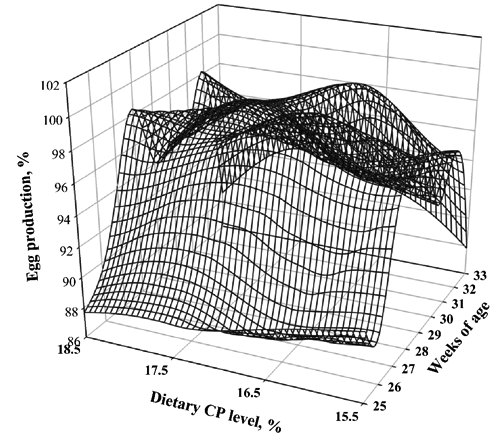
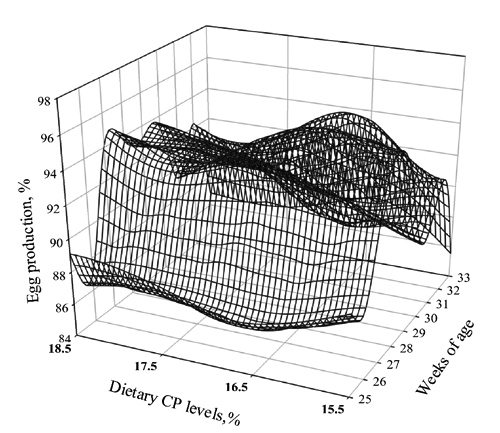
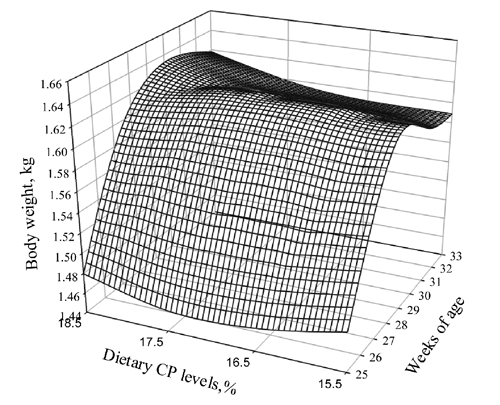

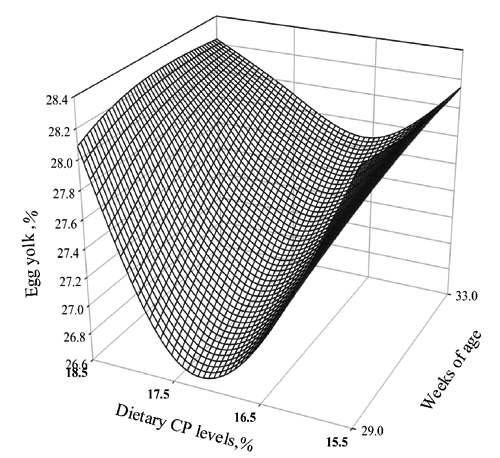
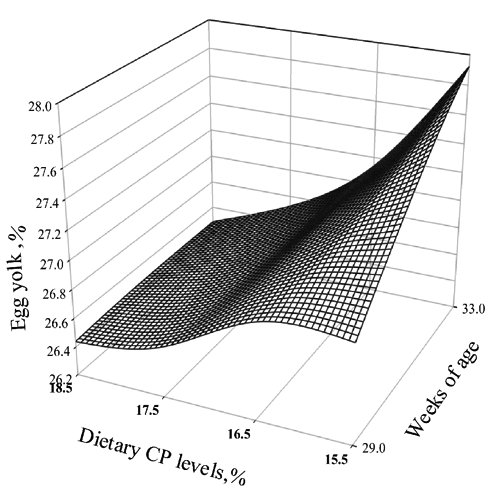
Table 1. Experimental diets for laying hens fed different dietary CP levels with fix ratio of total sulfur amino acids, Thr to Lys.
Table 2. Effect of dietary crude protein level on performance parameters of laying hens in two strains.
Table 3. Effects of dietary crude protein level and kind of strain on egg component percentage, haugh units, albumen height, shell quality characteristics, specific gravity and protein retention of laying hens.
Table 4. Performance, albumen height, haugh units and egg component status in laying hens receiving diets with different crude protein level: variables with significant (P≤0.05) crude protein × strain interactions.
Discussion
This experiment was conducted in order to improve management of protein levels in formulating the layer hens’ diet to reduce N excretion in the environment. The experiment used synthetic threonine in diets with no change in the amount of essential amino acids and considered the effects of differences between strains. Results show that egg production was not affected by dietary CP level. Harms and Russell (Citation1993) used a low protein diet (13%) supplemented with essential amino acids [meeting NRC (Citation1984) recommendations] and reported similar egg production when compared with a diet with 17% protein. The results of the present research are in agreement with those of Keshavarz and Jackson (Citation1992) who reported similar egg production (18-66 weeks of age) when using low protein diets in a phase feeding program (14%, 13%, and 12% protein) with supplemental Met, Lys, Trp, and Ile compared with positive control (18%, 16.5%, and 15% protein). A similar response was reported when utilizing a phasefeeding regimen of 15%, 14%, and 13% protein diets with adequate Met and Lys. Novak et al. (Citation2006) reported that the effect of low protein intake is more dramatic during the second phase (43-63 week of age) of egg production, which may indicate a delayed response to reduced protein intake or amino acids. Novak et al. (Citation2006) suggested that the reduction in egg production may also be the result of interactions among amino acids possibly due to an excessive intake of essential amino acids in the low protein diets. On the other hand, essential amino acids may have a limiting effect because of their conversion to nonessential amino acids that are in low concentration in low amino acid-low protein diets. Any differences in egg production in the current trial may have resulted from the compensatory effect of a constant amount of essential amino acids in their conversion to non-essential amino acids. Novak et al. (Citation2006) reported that as a result of decreased feed consumption when feeding the low protein diet, hens consumed lower total amounts of sulfur amino acids than recommended by the Hy-Line W98 breeders’ guidelines (Hy-Line International, Citation2006) and may have contributed to the reduction in egg production. Also, they reported that reducing protein intake from 18.9 to 17.0 g/hen per day and from 16.3 to 14.6 g/hen per day during phases I and II, respectively, with supplemental Lys, Met, Trp, and Thr, maintains egg production. In contrast to the report by Novak et al. (Citation2006), in the current study, reduction of dietary CP level resulted in a significant increase in feed intake. This may have compensated for the deficiency of sulfur amino acids and prevented a reduction in egg production contributing to a lower consumption of sulfur amino acids.
Egg weight was reduced when hens consumed diets with a low CP level. It has been reported that even when supplementing certain amino acids, egg weight is reduced due to other low amino acids (Penz and Jensen, Citation1991). A reduction in dietary protein reduces intake of non-essential amino acids such as Glu, Cys, and Gly, which are important N sources. These amino acids may become limiting for non-essential purposes, and may result in a limitation of protein (egg) synthesis. Penz and Jensen (Citation1991) reported a reduction in egg weight when feeding a low protein diet (13%) supplemented with Lys, Met, or Trp individually or in combination at a level 20% greater than NRC recommendations compared with control hens fed a 16% protein diet. Egg mass decreased linearly as dietary CP level decreased. It may have resulted from a reduction in egg weight without any changes in egg production. The negative effect of low protein diets with or without supplemental amino acids on egg mass has also been reported by other authors (Penz and Jensen, Citation1991; Summers et al., Citation1991; Keshavarz and Jackson, Citation1992). In contrast, Harms and Russell (Citation1993) reported similar responses in egg production parameters, including egg mass, when lowprotein diets (15% or 13%) with supplemental Lys, Met, Trp, Arg, Thr, Val, and Ile were compared with high protein (17.6% or 15.5%) diets. In the present study, a decrease in dietary CP level led to an increase in average daily feed intake. Feeding low protein diets has been reported to increase feed consumption in the past. Bartov (Citation1979) reported an increase in feed intake when feeding low protein diets to chickens, which was explained as the result of an amino acid appetite that results when feeding diets low in amino acids. Hurwitz et al. (Citation1998) reported that this may only be the case for certain amino acids, such as Lys and total sulfur amino acids, because diets low in Arg did not result in an increase in feed intake in growing chickens. Novak et al. (Citation2006) reported that decreasing protein intake reduced feed consumption by as much as 2 g/hen per day, whereas values for the medium and high protein diets were similar. They also suggested that an excessive amount of Lys, total sulfur amino acids and Thr in low protein diets may have satisfied the hens’ appetite for amino acids and reduced the feed intake. However, in the current study, a negative effect of low CP diets with constant amounts of digestible amino acids on feed intake was not observed. Poor feed efficiency in the current study resulted from increased feed consumption and a decrease in egg weight with low dietary CP level. Hens showed heavier weight in response to the increasing dietary CP level. Body weight gain decreased as dietary CP level decreased, and constant ratio of essential amino acids equal to the hens’ requirements did not compensate the low rate of weight gain. The effect of dietary CP level on body weight gain was more severe in Hy-line strain (). As shown in and , lower body weight gain resulting from a low protein diet is more pronounced when hens achieve their peak egg production. Deleterious effect of low protein diets on body weight gain at the time of peak egg production may result from shifting the amino acids from weight gain to egg production. In this study, egg components were not influenced by dietary CP level. Overall, egg yolk percentages were not affected by dietary CP level but an interaction was shown between the CP level and strain and egg yolk percentage that linearly increased as dietary CP level decreased in the Hy-line strain (). Penz and Jensen (Citation1991) reported a decrease in albumen percentage and an increase in yolk percentage as dietary protein decreased from 16% to 13%. Novak et al. (Citation2006) suggested that the changes observed may result from decreased amino acids available for albumen synthesis (production requirement). But because the yolk is synthesized in the liver, the synthesis for yolk protein synthesis remains constant during dietary protein reduction if the liver preferentially sequestered essential amino acids. In the current study, a constant amount of these three amino acids that were not changed by a reduction of CP level in diets may prevent albumen synthesis being reduced. Haugh units and albumen height were not affected by dietary CP level or strain. Researchers found no changes in Haugh units in the early phase (20-43 weeks of age) of the production cycle when feeding low protein diets (Novak et al., Citation2006; Deaton and Quisenberry, Citation1965; Aitken et al., Citation1973; and Leeson and Caston, Citation1997). On the other hand, Hamilton (Citation1978) observed no clear change in Haugh units when feeding low protein diets to 4 different strains of laying hens.
Overall, shell percentage was not affected by dietary CP level but a difference was seen between the strains. An interaction of dietary CP level and strain was observed for shell percentage. Reducing the level of CP increased the shell percentage in each strain (). On the other hand, shell thickness increased significantly as dietary CP level decreased. Although shell breaking strength was not significantly affected by feeding low protein diets, shell strength was numerically increased when the amount of protein in the diets was reduced. Novak et al. (Citation2006) suggested that hens consuming the low protein diets may produce an egg that has more adhering albumen on the shell than the other protein treatments. They suggested that the sulfur amino acid requirement for shell protein matrix synthesis needed to be considered to optimize shell quality. Results of the current study confirmed the findings of Novak et al. (Citation2006) and suggested that the essential amino acids amount could save shell quality from deleterious effects in low protein diets. Specific gravity was not affected by dietary CP level, which indicated that, considering the requirement amount of digestible sulfur amino acids, threonine and lysine in low protein diets could maintain shell quality. Protein retention was not significantly affected by dietary CP level. Novak et al. (Citation2006) suggested that hens consuming the low protein diets gained less weight, which may indicate that these hens used less protein per day. They suggested that it was possible that these hens were in a negative N balanced state, and any improvement in retention was reduced.
In the current study, significant differences in performance and egg quality between the strains were shown. Egg quality has a genetic basis and the parameters of egg quality vary between strains of hens (Pandey et al., Citation1986; Silversides et al., Citation2006). Curtis et al. (Citation1985) found that different strain of laying hens vary significantly in egg shell quality. Luiting (Citation1990) reported that different strains of laying hens showed significant differences in feed efficiency because of genetic differences, physical activity, physical condition, basal metabolic rate, body temperature, and body composition. Singh et al. (Citation2009) found interactions between environments, strains, and ages on hen-day egg production, BW, and egg quality over a period of time. These studies suggested that strain should be considered when using alternative housing systems and diets with differences in nutrient specifications.
Conclusions
Based on the results of this experiment, a reduction in dietary protein level (from 18.5% to 15.5%), without any alteration in digestible TSAA and Thr: Lys ratio, led to inferior egg mass and feed conversion ratio during peak production period. Although egg quality characteristics were not affected by CP reduction, hens consuming diets containing low CP produced eggs with improved shell quality as compared with those fed a high CP diet.
References
- AitkenJ.R.DickersonG.E.GoweR.S. 1973. Effect of intake and source of protein on laying performance of seven strains under single and double cage housing. Poultry Sci. 52:2127-2134.
- AOAC, 2000. Official Methods of Analysis, 17th ed. Association of Official Analytical Chemists, Gaithersburg, MD, USA.
- BartovI. 1979. Nutritional factors affecting quantity and quality of carcass fat in chickens. Fed. Proc. 38:2627-2639.
- BlairR.JacobJ.P.IbrahimS.WangP. 1999. A quantitative assessment of reduced protein diets and supplements to improve nitrogen utilization. J. Appl. Poultry Res. 8:25-47.
- CurtisP.A.GardnerF.A.MellorD.B. 1985. A comparison of selected quality and compositional characteristics of brown and white shell eggs. II. Interior quality. Poultry Sci. 64:302-306.
- DeatonJ.W.QuisenberryJ.H. 1965. Effects of dietary protein level on performance of fowl commercial egg production stocks. Poultry Sci. 44:936-942.
- HamiltonR.M.G. 1978. The effects of dietary protein level on productive performance and egg quality of four strains of White Leghorn hens. Poultry Sci. 57:1355-1364.
- HarmsR.H.RussellG.B. 1993. Optimizing egg mass with amino acid supplementation of a low-protein diet. Poultry Sci. 72:1892-1896.
- HurwitzS.SklanD.TalpazH.PlavnikI. 1998. The effect of dietary protein level on the lysine and arginine requirements of growing chickens. Poultry Sci. 77:689-696.
- Hy-Line International, 2006. Hy-Line W-36 Commercial Management Guide, 2004-2006. Hy-Line Int., West Des Moines, IA, USA.
- Hy-Line International, 2008. Hy-Line W-36 Commercial Management Guide, 2007-2008. Hy-Line Int., West Des Moines, IA, USA.
- JamrozD.OrdaJ.SkorupinskaJ.WiliczkiewiczA. 1996. Reducing of nitrogen excretions of the laying hens by feeding low crude protein mixtures and applying of feed supplements. Arch. Geflugelkd. 60:72-81.
- KeshavarzK.AusticR.E. 2004. The use of low-protein, low-phosphorus, amino acid and phytase supplemented diets on laying hen performance and nitrogen and phosphorus excretion. Poultry Sci. 83:75-83.
- KeshavarzK.JacksonM.E. 1992. Performance of growing pullets and laying hens fed low-protein, amino acid supplemented diets. Poultry Sci. 71:905-918.
- LeesonS.CastonL.J. 1997. A problem with characteristics of the thin albumen in laying hens. Poultry Sci. 76:1332-1336.
- LopezG.LeesonS. 1995. Response of broiler breeders to low-protein diets. 1. Adult breeder performance. Poultry Sci. 74:685-695.
- LuitingP. 1990. Genetic variation of energy partitioning in laying hens: causes of variation in residual feed consumption. World. Poultry Sci. J. 46:132-152.
- National Research Council, 1984. Nutrient Requirements of Poultry. 8th rev. ed. National Academy Press, Washington, DC, USA.
- NovakC.YakoutH.M.ScheidelerS.E. 2006. The effect of dietary protein level and total sulfur amino acid:lysine ratio on egg production parameters and egg yield in Hy-Line W-98 Hens. Poultry Sci. 85:2195-2206.
- PandeyN.K.MahapatraC.M.VermaS.S.JohariD.C. 1986. Effect of strain on physical egg quality characteristics in White Leghorn chickens. Int. J. Poultry Sci. 21:304-307.
- PenzA.M.JensenL.S. 1991. Influence of protein concentration, amino acid supplementation and daily time of access to high or low-protein diets on egg weight and components in laying hens. Poultry Sci. 70:2460-2466.
- SAS, 2003. SAS System for Mixed Models. SAS Inst. Inc., Cary, NC, USA.
- SchutteJ.B.JongJ.D.HolsheimerJ.P. 1992. Dietary protein in relation to requirement in poultry and pollution. pp 231-235 in Proc. 19th World’s Poultry Congr., Amsterdam, The Netherlands.
- SilversidesF.G.KorverD.R.BudgellK.L. 2006. Effect of strain of layer and age at photostimulation on egg production, egg quality, and bone strength. Poultry Sci. 85:1136-1144.
- SinghR.ChengK.M.SilversidesF.G. 2009. Production performance and egg quality of four strains of laying hens kept in conventional cages and floor pens. Poultry Sci. 88:256-264.
- SummersJ.D. 1993. Reducing nitrogen excretion of the laying hen by feeding lower crude protein diets. Poultry Sci. 72:1473-1478.
- SummersJ.D.AtkinsonJ.L.SprattD. 1991. Supplementation of a low protein diet in an attempt to optimize egg mass output. Can. J. Anim. Sci. 71:211-220.